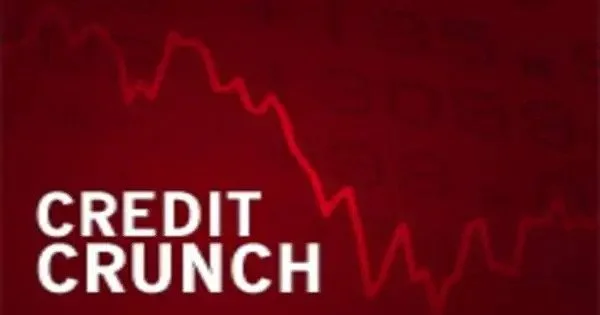The term “credit crunch” refers to a situation in which access to credit becomes significantly more difficult for borrowers. A credit crunch is a sudden decrease in the general availability of loans or a sudden tightening of the requirements for obtaining a loan from a bank. This can occur for various reasons, such as a decline in the overall availability of credit, a tightening of lending standards by financial institutions, or a decrease in investor confidence.
A credit crunch generally involves a reduction in the availability of credit independent of a rise in official interest rates. During a credit crunch, borrowers may find it harder to obtain loans or credit lines, and interest rates may rise. This can have significant economic impacts, as businesses may struggle to secure financing for expansion or to meet their operating expenses, and consumers may find it more challenging to finance purchases or meet their debt obligations. The relationship between credit availability and interest rates shifts in such circumstances.
Credit becomes less available at any given official interest rate, or there ceases to be a clear relationship between interest rates and credit availability (i.e. credit rationing occurs) (i.e. credit rationing occurs). A credit crunch is frequently accompanied by a flight to quality among lenders and investors seeking less risky investments (often at the expense of small to medium size enterprises).
Causes
A credit crunch is often caused by a sustained period of careless and inappropriate lending which results in losses for lending institutions and investors in debt when the loans turn sour and the full extent of bad debts becomes known.
Credit crunches can be triggered by a variety of factors, such as a financial crisis, a recession, or a decline in the value of certain types of assets. Governments and central banks may respond to a credit crunch by implementing policies designed to stimulate lending and ease the availability of credit, such as lowering interest rates or providing financial support to struggling institutions.
Effects
Financial institutions facing losses may then reduce the availability of credit, and increase the cost of accessing credit by raising interest rates. In some cases, lenders may be unable to lend further, even if they wish, as a result of earlier losses. If participants themselves are highly leveraged (i.e., carrying a high debt burden) the damage done when the bubble bursts is more severe, causing recession or depression.
Financial institutions may fail, economic growth may slow, unemployment may rise, and social unrest may increase. For example, the ratio of household debt to after-tax income rose from 60% in 1984 to 130% by 2007, contributing to (and worsening) the Subprime mortgage crisis of 2007–2008.
















